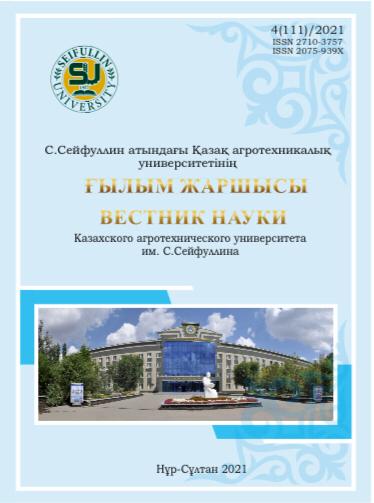PHYSICO-CHEMICAL STRUCTURE PROPERTIES OF CATIONIC POTATO STARCH OBTAINED BY SUSPENSION («WATERY») WAY METHOD
DOI:
https://doi.org/10.51452/kazatu.2021.4(111).804Keywords:
starch, cationization, modification, reagent, properties.Abstract
A highly efficient starch cationization method in suspension with a cation-containing reagent CHPTAC in an alkaline medium with gelatinization inhibitors has been developed, which makes it possible to obtain cationic starch with 0,01–0,06 mol/mol substitution degree. Scanning electron photographs of native and cationic starches granules showed the starch granules destruction with an increase in cationization degree. 13C NMR, 1H NMR and IR-spectra indicates analysis α-D-glucopyranose presence as the main structural element, as well as the presence of an epichlorohydrin group that replaces the hydroxide at α-D-glucopyranose 2C, 3C, and positions 6C. In this case, the process of substitution in different positions of α-D-glucopyranose occurs unevenly (at different rates) and is carried out as follows: 2C> 6C> 3C. Diffraction patterns indicate a significant decrease in the degree of crystallinity (from 33,2% for native starch to 28% for cationic starch with DS 0,035 and up to 0% for cationic starches with DS 0,061 and 0,045) of potato starch after its cationization at temperatures leading to strong swelling starch granules in the reaction mixture, and these changes are the more significant, the higher the reaction temperature. In this case, the substitution process in different positions of α-D-glucopyranose occurs unevenly (at different rates) and is carried out as follows: 2C>6C>3C. Diffraction patterns indicate a significant decrease in the crystallinity degree (from 33,2% for native starch to 28% for cationic starch with DS 0,035 and up to 0% for cationic starches with DS 0,061 and 0,045) of potato starch after cationization at temperatures leading to strong swelling starch granules in the reaction mixture, and these changes are the more significant, the higher the reaction temperature. The main native potato starch reflexes characteristic (2q = 17,0, 19,5 and 22,1°) are practically not expressed in cationic starch samples synthesized at Т ³ 45°C. Diffraction patterns of cationic potato starch samples with various substitution degrees, obtained at 35°C, are characterized by the reflex absence at 2q = 19,5° and the clear bands presence with maxima around 2q = 17,0 and 22,1°. Non-isothermal thermogravimetric curves of native potato starch and three cationic potato starch samples showed that the cationic groups into the starch macromolecule introduction has a significant effect on the starch thermal characteristics, mainly on the initial temperature and degradation mechanism. All studied samples lose weight in two stages: the first (70–100°C) is associated with the adsorbed moisture removal, and the second (220–287°C) is directly caused by the polymer degradation and decomposition (carbonization). In this case, carbonization of all cationic starch samples begins at lower temperatures than for native starch.

